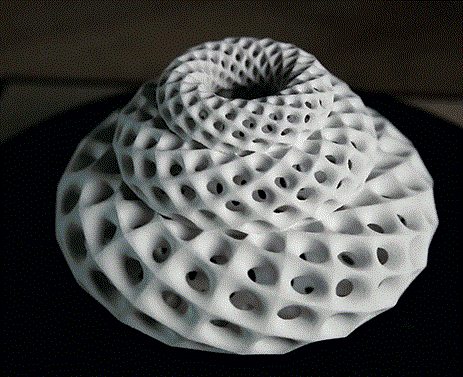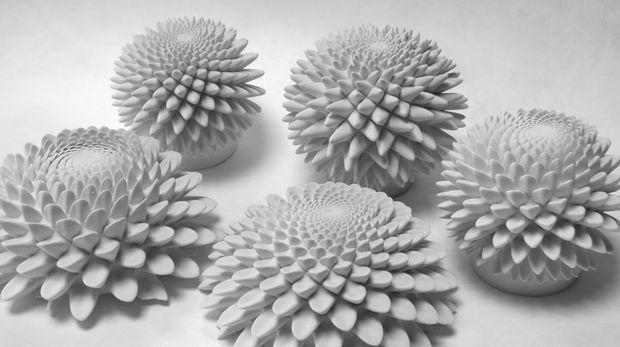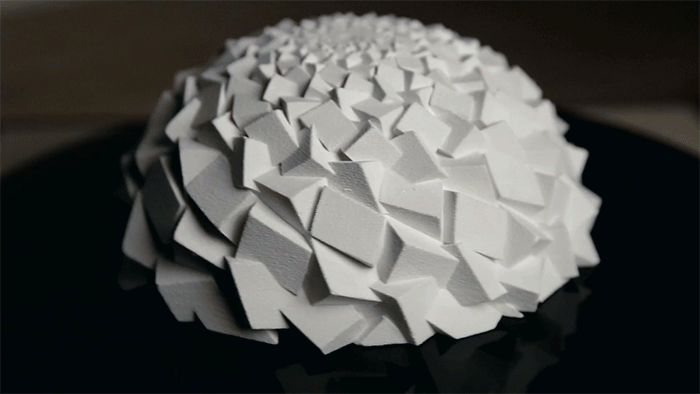Nature is filled with numbers — or possibly numbers are filled with nature. Either way, artists have been exploring the relationships between numerical form and physical form for as long as the human mind has been aware of either. Scholars have long debated the intentionality behind the proportions assigned to constructions such as the Parthenon and the Egyptian pyramids. Da Vinci’s explorations of the proportions of the human body echoed those done by the Greeks and foreshadowed those done by Le Corbusier.
Artist John Edmark’s most recent work, Blooming Zoetropes, explorse the perceptual possibilities of physical forms created by spinning sculptures. The sculptures’ forms appear to be continuallyand cyclically blooming as they are captured on high speed camera while rotating at 550 RPM. The video, filmed at 24 frames per second, is synchronized with the spinning so that each frame of video shows the sculpture having completed 137.5° of a complete turn. The selection of this particular segment of the rotation is intentional as it designates the golden angle. Edmark explains:
“Each petal on the sculpture is placed at a unique distance from the top-center of the form. If you follow what appears to be a single petal as it works its way out and down the sculpture, what you are actually seeing is all the petals on the sculpture in the order of their respective distances from the top-center.”
It’s a very convincing illusion. Edmark has been kind enough to share the process for creating these Blooming Zoetropes on Instructables and I can imagine that an entire taxonomy of forms will soon be spinning their way through video footage across the globe.
Edmark’s explanation on Instructables is more than just your typical set of directions. Instead, it’s a mini course in mathematics designed to make you comfortable with the concepts behind the  creation of such forms. He covers topics such as the golden ratio and the famous Fibonacci Sequence with links to webpages containing more information about those concepts.
creation of such forms. He covers topics such as the golden ratio and the famous Fibonacci Sequence with links to webpages containing more information about those concepts.
In fact, it’s worth going through the instructions just to watch the other videos of Edmark’s explorations even if you never plan on creating your own zoetropic sculpture. The first two videos capture a creation rendered through the Fibonacci Sequence that would be an amazing introduction to the concept to be used in math classrooms and represents the best of kinetic learning. I can imagine that working with such abstract mathematical constructs in a physical way would capture the attention of students who generally dismiss higher mathematics as ‘impractical.’
After this initial ‘hook’ Edmark gets down to the nuts and bolts of creating the zoetropic sculpture. For his sculptures, he created models using Python scripting for Rhino and then exported the files as STL. He then printed them using a Zprinter 450. He even offers to share the STL files that he created for those who simply want to print his works directly.
It is especially entertaining to watch his demonstration of the relationship between the forms that he has artificially created and those that nature produces on her own. As these mathematical relationships are present in nature, the same blooming effect can be seen when rotating a related plant form. To demonstrate this principle, Edmark created what very well may be, the only high speed[1] video of spinning artichoke ever to have been uploaded to YouTube.
The forms are somewhat hypnotizing, almost difficult to take your eyes off of. In fact, as the videos are on a loop, I found that I had to open up a blank browser tab while writing this in order not to be continually sucked back in to staring at the spinning forms. If we lived in Marvel Comics, it would only be a matter of time before they fell into the hands of a super villain and were used to control people’s minds (disclaimer: I have no evidence that Edmark has any such nefarious intentions or that it would be possible to use these for anything but the forces of good.)
While spinning artichokes and blooming zoetropes may be fantastic eye candy, they also offer insight into the fascinating connections between mathematics and visual form that should lead to continuing exploration and inspiration.
Are these forms something that interests you? Tell us your thoughts on these Fibonacci-inspired zoetropes in the Blooming Zoetropes forum thread over at 3DPB.com.
Subscribe to Our Email Newsletter
Stay up-to-date on all the latest news from the 3D printing industry and receive information and offers from third party vendors.
Print Services
Upload your 3D Models and get them printed quickly and efficiently.
You May Also Like
Metal Powder Supplier Elementum 3D Added to $46B Air Force Contract
Elementum 3D, a Colorado-based developer and supplier of metal powders used in additive manufacturing (AM), announced that the company has been added to the vendors list in the fourth on-ramp...
Ursa Major Lands $28.6M AFRL Deal for 3D Printed Draper Engine Flight Demo
The US Air Force Research Laboratory’s (AFRL’s) Rocket Propulsion Division at Edwards Air Force Base has awarded a $28.6 million contract to Ursa Major for follow-on work related to the...
3D Printing Financials: Rocket Lab’s Record-Breaking Year and Over 20 Launches Coming in 2025
Rocket Lab (Nasdaq: RKLB) closed 2024 with its best year yet. The company launched more rockets, signed more contracts, and expanded deeper into spacecraft and satellite production than ever before....
US Air Force Taps Beehive to Study 3D Printed Jet Engines
Propulsion 3D printing firm Beehive Industries secured a contract from the U.S. Air Force Life Cycle Management Center through SOSSEC. SOSSEC is a company that manages Other Transactions Authority (OTA)...


































